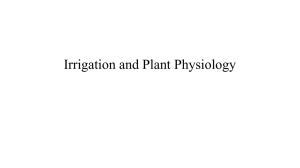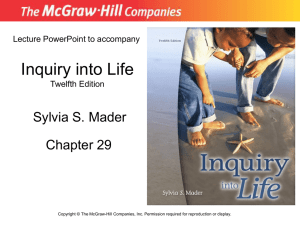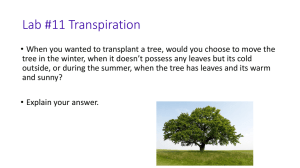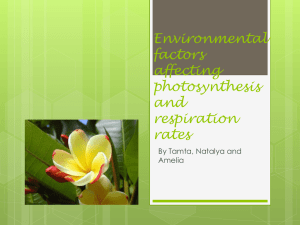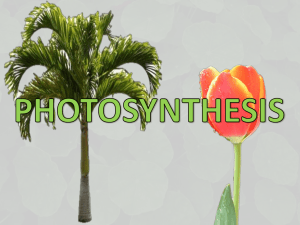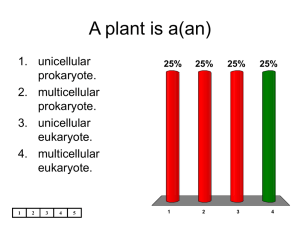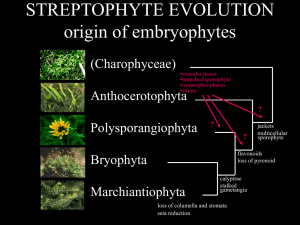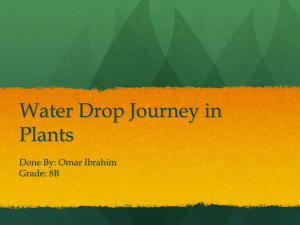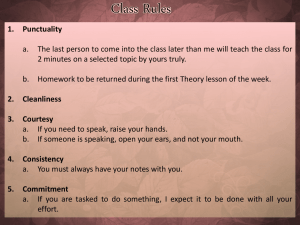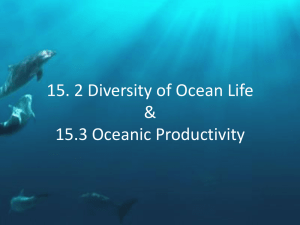Photosynthesis
advertisement
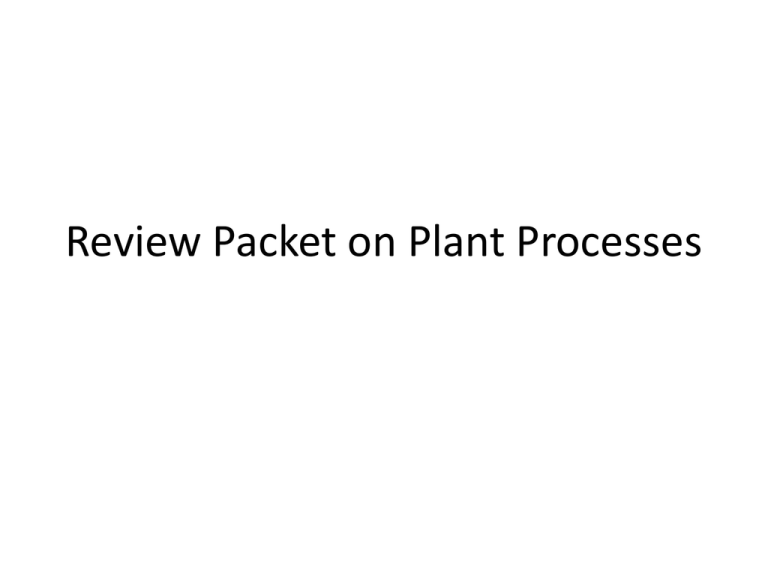
Review Packet on Plant Processes In a process called _____________, plants convert energy stored in food into a form of energy that cells can use. A. transpiration B. Photosynthesis C. Cellular respiration D. phototropism In a process called _____________, plants convert energy stored in food into a form of energy that cells can use. A. transpiration B. Photosynthesis C. Cellular respiration D. phototropism The tendency of shoot tips of plants to grow and bend toward the light is call ____________. A. Gravitropism B. Phototropism C. Plant growth D. Transpiration The tendency of shoot tips of plants to grow and bend toward the light is call ____________. A. Gravitropism B. Phototropism C. Plant growth D. Transpiration Seeds become ___________ in order to survive periods of drought or cold temperatures. A. Dormant B. Deciduous C. Dead D. Alive Seeds become ___________ in order to survive periods of drought or cold temperatures. A. Dormant B. Deciduous C. Dead D. Alive Most of the water absorbed by a plant’s roots is needed to replace the water lost during _____________. A. Winter B. Summer C. Phototropism D. Transpiration Most of the water absorbed by a plant’s roots is needed to replace the water lost during _____________. A. Winter B. Summer C. Phototropism D. Transpiration A houseplant that is bending toward a sunlit window is A. Displaying a positive tropism. B. Displaying a negative tropism. C. Undergoing genetic change D. Showing a seasonal effect. A houseplant that is bending toward a sunlit window is A. Displaying a positive tropism. B. Displaying a negative tropism. C. Undergoing genetic change D. Showing a seasonal effect. The root tips of most plants show A. Negative phototropism. B. Positive gravitropism. C. Positive phototropism. D. Negative gravitropism. The root tips of most plants show A. Negative phototropism. B. Positive gravitropism. C. Positive phototropism. D. Negative gravitropism. Plant cells make glucose molecules from A. CO2 and O2 B. C6H12O6 C. H20 and H2 D. CO2 and H2O Plant cells make glucose molecules from A. CO2 and O2 B. C6H12O6 C. H20 and H2 D. CO2 and H2O The energy that powers photosynthesis comes from A. Light given off by the sun. B. Collisions of gas molecules in the air. C. The breakdown of sugar molecules inside plant cells. D. Chlorophyll absorbed through the soil. The energy that powers photosynthesis comes from A. Light given off by the sun. B. Collisions of gas molecules in the air. C. The breakdown of sugar molecules inside plant cells. D. Chlorophyll absorbed through the soil. A plant seed develops from A. An ovary. B. An ovule. C. A sepal. D. A pollen tube. A plant seed develops from A. An ovary. B. An ovule. C. A sepal. D. A pollen tube. Plants die without sunlight because they are unable to carry out _____________. A. Cellular respiration B. Photosynthesis C. Phototropism D. pollination Plants die without sunlight because they are unable to carry out _____________. A. Cellular respiration B. Photosynthesis C. Phototropism D. pollination For photosynthesis to occur, plants must take in light energy, carbon dioxide, and water. In addition to sugar plants produce ___________ A. N B. P C. K D. O For photosynthesis to occur, plants must take in light energy, carbon dioxide, and water. In addition to sugar plants produce ___________ A. N B. P C. K D. O Plants cells have organelles called chloroplasts, where photosynthesis takes place. These organelles contain a pigment call ___________ that absorbs light. A. Cytoplasm B. Ribosomes C. Mitochondria D. Chlorophyll Plants cells have organelles called chloroplasts, where photosynthesis takes place. These organelles contain a pigment call ___________ that absorbs light. A. Cytoplasm B. Ribosomes C. Mitochondria D. Chlorophyll Cellular respiration uses oxygen to release energy from glucose. It also releases ________ and __________. A. Nitrogen and water B. Water and Phosphorus C. Carbon dioxide and water D. Carbon dioxide and nitrogen Cellular respiration uses oxygen to release energy from glucose. It also releases ________ and __________. A. Nitrogen and water B. Water and Phosphorus C. Carbon dioxide and water D. Carbon dioxide and nitrogen The chemical formula for cellular respiration is A. C6H12O6 + 6O2 > 6CO2 + 6H2O + energy B. C6H12O2 + 6O2 > 6CO2 + 6H2O + energy C. C6H12O6 + 6H2O > 6CO2 + 6H2O + energy D. C6H12O2 + 6H2O >6CO2 + 6H2O + energy The chemical formula for cellular respiration is A. C6H12O6 + 6O2 > 6CO2 + 6H2O + energy B. C6H12O2 + 6O2 > 6CO2 + 6H2O + energy C. C6H12O6 + 6H2O > 6CO2 + 6H2O + energy D. C6H12O2 + 6H2O >6CO2 + 6H2O + energy In the sporophyte phase, a seed grows into a plant that produces _____________. A. Sperms B. Eggs C. Spores D. More seeds In the sporophyte phase, a seed grows into a plant that produces _____________. A. Sperms B. Eggs C. Spores D. More seeds In the gametophyte phase, spores grow into plants that produce _________ and _______. A. Male spores and female spores. B. Eggs and sperm C. More spores and eggs D. More spores and sperm. In the gametophyte phase, spores grow into plants that produce _________ and _______. A. Male spores and female spores. B. Eggs and sperm C. More spores and eggs D. More spores and sperm. Both seed and seedless plants reproduce A. Asexually B. In water C. Sexually D. Using pollen Both seed and seedless plants reproduce A. Asexually B. In water C. Sexually D. Using pollen ___________, a form of asexual reproduction, are above-ground stems that can grow into new plants—an example would be strawberries. A. Runners B. Tubers C. Plantlets D. Sperm ___________, a form of asexual reproduction, are above-ground stems that can grow into new plants—an example would be strawberries. A. Runners B. Tubers C. Plantlets D. Sperm Plant stomata are usually open during the day because A. Photosynthesis can occur while there is sunshine available. B. Cellular respiration can occur while there is sunshine available. C. It gives the plant a rest. D. That’s when more carbon dioxide is available. Plant stomata are usually open during the day because A. Photosynthesis can occur while there is sunshine available. B. Cellular respiration can occur while there is sunshine available. C. It gives the plant a rest. D. That’s when more carbon dioxide is available. A stimulus of too little water in a plant would trigger the A. Opening of stomata to collect more water. B. Leaves to produce more sugar. C. Closing stomata to preserve water. D. Beginning of more N, P, and K from the roots. A stimulus of too little water in a plant would trigger the A. Opening of stomata to collect more water. B. Leaves to produce more sugar. C. Closing stomata to preserve water. D. Beginning of more N, P, and K from the roots. Photosynthesis takes place in A. Roots B. Mitochondria C. Leaves D. Stem Photosynthesis takes place in A. Roots B. Mitochondria C. Leaves D. Stem Flowering plants produce _________ . A. Spores B. Tubers C. Seeds D. runners Flowering plants produce _________ . A. Spores B. Tubers C. Seeds D. runners Growth, wilting, and dormancy are examples of plant A. Photosynthesis B. Responses C. Stimuli D. Cellular respiration Growth, wilting, and dormancy are examples of plant A. Photosynthesis B. Responses C. Stimuli D. Cellular respiration _____________ is the transfer of pollen from the male reproductive structures to the female structures of seed plants. A. Reproduction B. Transpiration C. Dormancy D. Pollination _____________ is the transfer of pollen from the male reproductive structures to the female structures of seed plants. A. Reproduction B. Transpiration C. Dormancy D. Pollination The process by which plants release water vapor into the air through stomata is called ________. A. Transpiration B. Stamen C. Photosynthesis D. Cellular respiration The process by which plants release water vapor into the air through stomata is called ________. A. Transpiration B. Stamen C. Photosynthesis D. Cellular respiration • What material do plants make during photosynthesis? • A. glucose B. organelles C. chlorophyll D. carbon dioxide • What material do plants make during photosynthesis? • A. glucose B. organelles C. chlorophyll D. carbon dioxide • What substance found within the chloroplasts of leaves is responsible for capturing light energy during photosynthesis? • A. water B. oxygen C. chlorophyll D. carbon dioxide • What substance found within the chloroplasts of leaves is responsible for capturing light energy during photosynthesis? • A. water B. oxygen C. chlorophyll D. carbon dioxide • What is an example of internal stimulus to which plants can respond? • A. light B. hormones C. temperature • D. soil conditions • What is an example of internal stimulus to which plants can respond? • A. light B. hormones C. temperature • D. soil conditions • The town of Pleasantville experienced a very hot, dry summer with very little wind. How can these conditions affect the reproduction of seed plants? • A. Pollen travels on wind and water, so the conditions could affect the ability of pollen to travel. • B. Pollen requires hot temperatures and dry conditions, so the conditions could help many plants thrive. • C. The conditions are external stimuli that could trigger a change in behavior in plants; they might wilt or die. • D. Seed plants need water for sperm to swim, so the dry conditions could make it harder for the sperm of seed plants to fertilize eggs. • The town of Pleasantville experienced a very hot, dry summer with very little wind. How can these conditions affect the reproduction of seed plants? • A. Pollen travels on wind and water, so the conditions could affect the ability of pollen to travel. • B. Pollen requires hot temperatures and dry conditions, so the conditions could help many plants thrive. • C. The conditions are external stimuli that could trigger a change in behavior in plants; they might wilt or die. • D. Seed plants need water for sperm to swim, so the dry conditions could make it harder for the sperm of seed plants to fertilize eggs. • As you walk past a field of sunflowers, you notice the flowers are all facing the same direction. This is an example of what? • A. transpiration B. phototropism C. photosynthesis D. sexual reproduction • As you walk past a field of sunflowers, you notice the flowers are all facing the same direction. This is an example of what? • A. transpiration B. phototropism C. photosynthesis D. sexual reproduction • Which of the following is a plant structure that is involved in asexual reproduction? • A. stigma • B. stamen • C. Pistil • D. tuber • Which of the following is a plant structure that is involved in asexual reproduction? • A. stigma • B. stamen • C. Pistil • D. tuber • What are the two phases of the plant life cycle? • A. zygote and seed B. spores and flowers C. sporophyte and zygote • D. sporophyte and gametophyte • What are the two phases of the plant life cycle? • A. zygote and seed B. spores and flowers C. sporophyte and zygote • D. sporophyte and gametophyte • Which of the following is a function of stomata? • A. absorb sunlight B. release glucose C. release water vapor • D. absorb water through the roots • Which of the following is a function of stomata? • A. absorb sunlight B. release glucose C. release water vapor • D. absorb water through the roots • Which plant life phase begins when two gametes fuse together to form a zygote? • A. sporophyte • B. gametophyte C. both sporophyte and gametophyte • D. neither sporophyte or gametophyte • Which plant life phase begins when two gametes fuse together to form a zygote? • A. sporophyte • B. gametophyte C. both sporophyte and gametophyte • D. neither sporophyte or gametophyte • Which of the following scenarios could cause stomata to close? • A. The plant lives near a wetland area. B. The soil around the plant is very wet. C. The soil around the plant is very dry. • D. Rain has fallen every day for ten days. • Which of the following scenarios could cause stomata to close? • A. The plant lives near a wetland area. B. The soil around the plant is very wet. C. The soil around the plant is very dry. • D. Rain has fallen every day for ten days.
